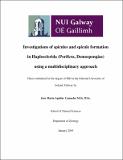| dc.description.abstract | Sponges are simple animals and their body is formed by different cell types and a dense skeleton either of collagen, chitin or spicules made of amorphous silica or calcium carbonate that they secrete. The phylum Porifera is divided into four classes, and Demospongiae is the most diverse. The identification and classification of demosponges is primarily based on spicule morphology and the arrangement of these structures in their skeleton. Species belonging to the order Haplosclerida have a skeleton composed mainly of megasclere spicules in a single size category and microscleres if present include sigmas, toxas or microxeas. The classification of this order is complicated and there is discrepancy between the morphological classification and the molecular phylogeny based on ribosomal, nuclear and mitochondrial topologies. In this thesis, a multidisciplinary approach including chemistry, microscopy and genetics was used to gain insights into the formation of spicules in selected marine haplosclerid species.
The chemical composition of the spicules was analyzed in nine Haliclona species employing SEM-EDS, ICP-MS, ICP-OES and FTIR-ATR and no phylogenetic pattern was obtained from these analyses and the amounts of biogenic silica was similar in these species. The spicules of one species (H. indistincta) contained the highest amounts of trace elements compared to the remaining eight Haliclona species and the cause of this difference could be due to environmental factors. The genes responsible for spicule formation (silicatein and silintaphin) were identified in de novo assembled transcriptomes from three Haliclona species (representatives of three major molecular clades), and in all the available genomes and transcriptomes from Porifera. The silicatein genes were just found in genomes and transcriptomes from Demospongiae bearing siliceous spicules (excluding Keratosa and Verongimorpha) and a new scheme is proposed in which these genes are divided into six major molecular clades (CHNI, CHNII, CHNIII, C/SQN, SHNI and SHNII), however one silicatein from H. indistincta was located between the overall silicatein clade and cathepsin-L clade (outgroup). There is a high duplication of silicatein genes and despite the paralogous copies the evolution of these genes in marine haplosclerids reflects the previous molecular topology. I suggest that the simplicity of skeleton in marine haplosclerids is maybe because the transcriptomes and genomes analyzed in this study have only one silicatein of the SHNI type and the absence of the silintaphin protein and SHNII silicatein variants. The analysis of the expression levels of the silicatein genes from the sponge H. indistincta through three different developmental stages was investigated and the cells producing spicules and the axial filament protein were identified using microscopic analyses (TEM and SEM). There was positive correlation between the expression levels of silicatein genes with the formation of spicules. In addition, these genes were differentially expressed in two developmental stages producing spicules (pre-settled stage and adult). One silicatein gene from H. indistincta was expressed in E.coli cells for the production of a recombinant protein. This latter task was carried out for the production of silica nanocrystals for the biotech sector and as a functional study to understand the diversity of silicatein variants from this species. The protein was successfully produced but unfortunately, the refolding and purification was not possible to accomplish. | en_IE |


